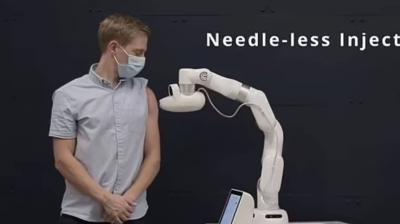A Canadian startup has successfully transformed the process of receiving the COVID-19 vaccine from needle injections to a much easier procedure, where a robot pumps the vaccine dose directly into the muscle without using a needle, as reported by the British "Daily Mail." The developers of the robot, named "Kubi," designed at the University of Waterloo in Ontario, claim it has successfully performed the first autonomous robotic intramuscular injection.
It utilizes a high-pressure jet injection system for the serum to pass through an opening in the skin the width of a human hair. By using LiDAR sensors, the same technology that self-driving cars use to map the road, Kubi creates a model of the patient's body and determines, through artificial intelligence software, the optimal injection site for the vaccine or medication.
Tim Laswell, co-founder and CEO of Kubeonix, stated: "Kubi is equipped with needle-free injection technology to demonstrate that patients can receive muscle injections, like vaccines, without needles and without the need for a healthcare professional."
**No Contact**
In theory, a patient registers online to book an appointment, then arrives at a clinic or pharmacy and presents their identity to the camera on Kubi's interface for verification. The 3D sensors determine the patient's position and the ideal site for receiving the vaccine using LiDAR sensors before injecting the vaccine, without the need for needle stick or contact with any humans. Kubi was launched in 2019 after being developed at the University of Waterloo's innovation incubator.
**Full Autonomy**
Kubi can help address the shortage of healthcare workers, especially in the area of COVID-19 vaccinations. The company's officials see the robot being employed in various applications. Laswell explained that "Kubi is a versatile robotic platform that can be quickly deployed to complete tasks autonomously at 100%."
Developers of Kubi have initially targeted healthcare, hospitality, and cleaning technologies as "all these industries are suffering from labor shortages and low efficiency," noting that it will take about two years before Kubi is ready for commercial use.
**A Boom During the Pandemic**
The COVID-19 pandemic has led to a boom in robotics aimed at compensating for employee shortages and avoiding face-to-face interactions amid precautionary measures such as physical distancing. For example, a nurse robot at Cira-03 Hospital, with a human-like face and arms, conducts SARS-CoV-2 tests and alerts patients to wear masks if they are not wearing one.
Additionally, Harvard Medical School has used the robotic dog "Spot," produced by Boston Dynamics, to detect COVID-19 symptoms from a distance of two meters in its facilities. "Spot" also handles other secondary procedures, including assessing vital signs and placing IV catheters, while an iPad connected to "Spot" allows doctors and nurses to conduct remote healthcare interviews with patients via real-time video calls.




